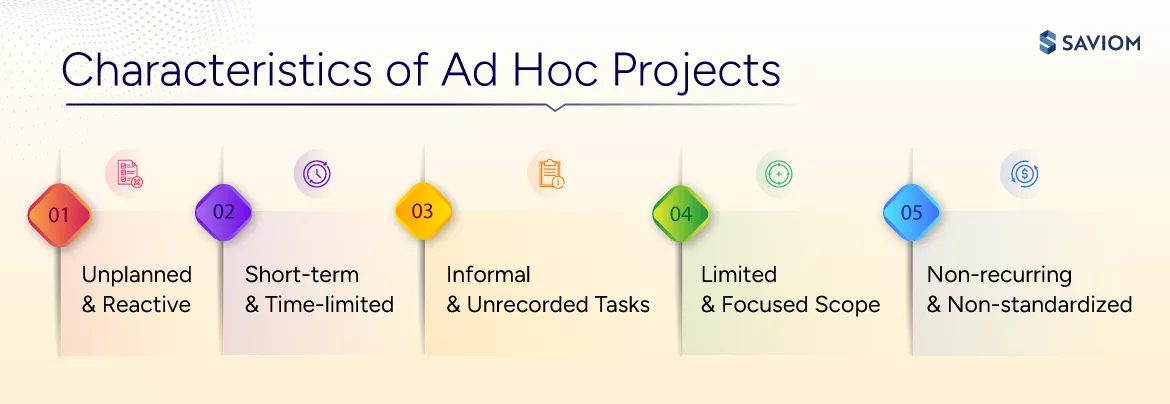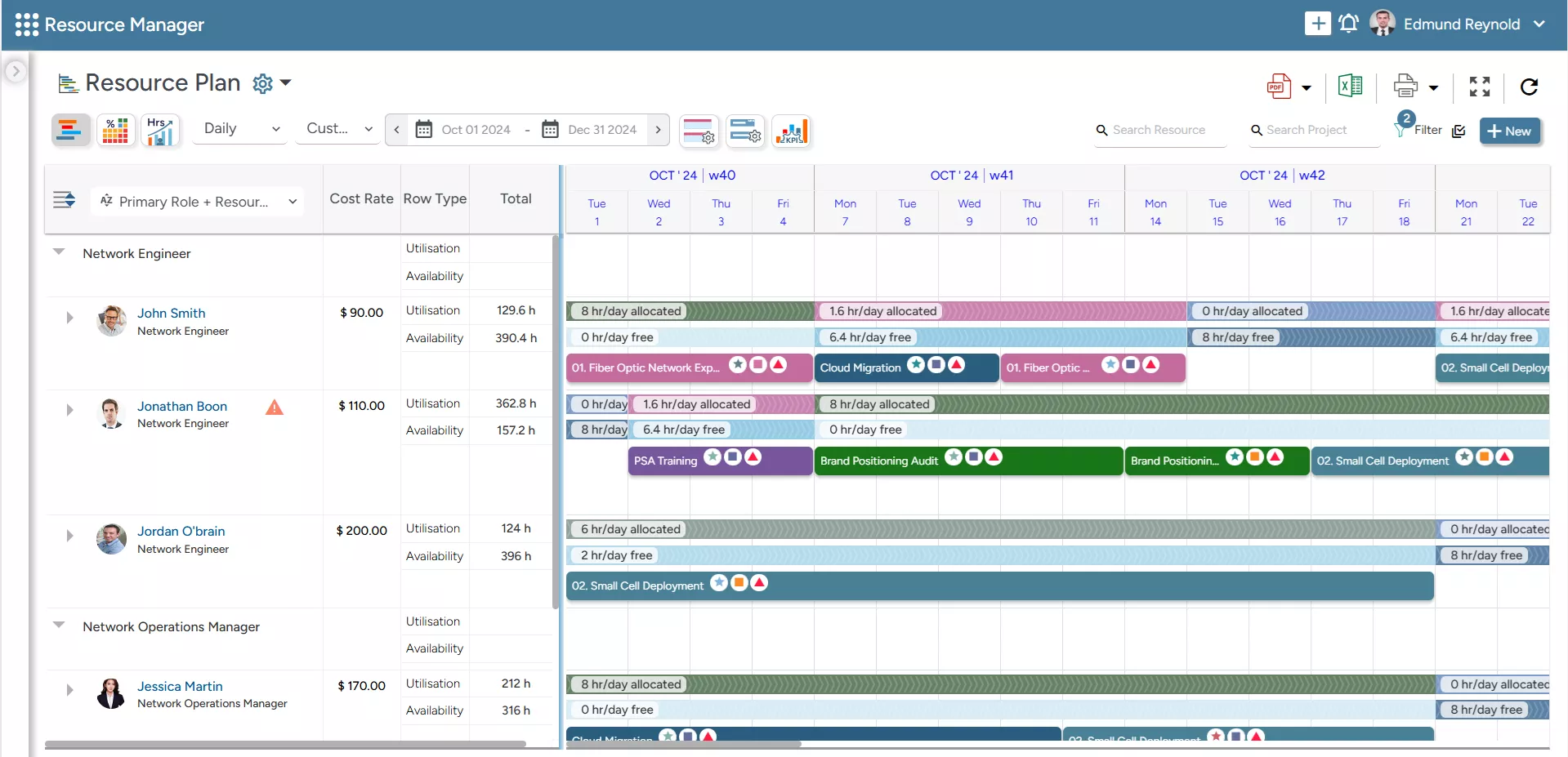As a project manager, you would have encountered sudden requests like:
“Prepare a presentation over the weekend for a last-minute client meeting scheduled on Monday.”
“Troubleshoot and analyze the root cause of the unexpected server outage by the end of the day.”
“Conduct a flash financial audit of a specific department, as we have detected some unusual activities.”
These spontaneous and occasional requests are typical examples of ad hoc projects that often arise without prior notice. Unlike planned projects, ad hoc requests have shorter timeframes, higher urgency, and are carried out without formal processes. While they seem minor, mismanaged ad hoc projects can derail the original workflow and overwhelm your team, leading to burnout.
In this blog, we will discuss ad hoc projects, the consequences of not tracking them, and strategies to manage them effectively.
What are Ad Hoc Projects?
Ad hoc projects are unplanned, one-time initiatives that are taken up to address specific issues or special requests. The key characteristics of such projects are:
- They need immediate attention.
- The deadlines are short and stringent.
- They don’t follow the formal structure of normal projects.
Due to their spontaneous nature, ad projects require quick decision-making, a flexible approach, and rapid reallocation of resources to adapt to sudden changes.
Now that we understand an ad hoc project let’s look at its characteristics.
Characteristics of Ad-Hoc Projects
Below are the common characteristics of ad-hoc projects:
Unplanned & Reactive
Ad hoc projects arise because of sudden problems or urgent business needs that require quick action. Thus, these projects are often unplanned and reactive in nature. Project managers usually have to make quick decisions and shift priorities to accommodate these assignments.
Short-term & Time-limited
These spontaneous requirements are usually triggered by special requests or unexpected issues that need to be addressed within a short time frame. Whether it is an urgent request for a client report or same-day resolution of a bug, these projects require quick turnaround. Thus, leaving little room for detailed planning or structured execution.
Informal & Unrecorded Tasks
Ad hoc projects are often informal and unrecorded because they arise unexpectedly. Since they’re meant to fulfill an immediate demand, there’s often no time for formal planning, documentation, or tracking. This makes it difficult to track progress and evaluate efforts after completion.
Limited & Focused Scope
An ad hoc project is created to solve immediate needs, such as preparing a one-time presentation or conducting a quick audit. Thus, these last-minute assignments typically have a focused, narrow, and clearly defined project scope, allowing teams to concentrate efforts on a singular goal and achieve it in a given time frame.
Non-Recurring & Non-Standardized
Most ad hoc projects are one-time activities initiated to fulfill immediate and specific needs. Unlike planned projects, they do not follow a recurring pattern. Additionally, they have a non-standardized nature, which implies that they often lack predefined workflows and repeatable processes. This lack of consistency makes it more difficult to track and manage these requests.

To understand ad hoc projects more clearly, let’s consider an example.
Ad Hoc Project Example
Here is an example of an ad hoc project in a law firm:
Imagine a law firm suddenly receiving an urgent request from a major client to prepare a legal report within 24 hours for a court hearing in just two days. Here is why it is an ad hoc project:
- Unplanned: The request arises without prior information.
- Time-limited: The report needs to be prepared within a 24-hour window.
- Informal: The request is made via email instead of a formal intake process.
- Limited Scope: The deliverable is specific. Only the legal report is required for the hearing
- Non-recurring: This is a one-time request, unlikely to be repeated.
In response, the project manager quickly form a small team of legal experts that review all the necessary information, analyze the details, and draft the report. Finally, the completed report is delivered to the client on time. This example illustrates how a law firm responds effectively to an ad hoc project.
Next, we’ll look at why monitoring ad hoc projects is essential.
Read More: 7 Project Manager Personality Types: Which One Is Yours?
Why is it Important to Track Ad Hoc Projects?
Although ad hoc projects are often sudden, high-priority, and time-bound, tracking them is essential for several key reasons:
- Ad-hoc projects often disrupt the flow of planned initiatives. By tracking them, managers can evaluate the time and effort required. This enables them to adjust the project schedule accordingly and minimize disruption.
- Scheduled and ad hoc projects compete for the same resources. By tracking ad-hoc work, managers can understand the patterns of spontaneous requests and create a buffer to avoid resource constraints.
- When unplanned tasks pile up without visibility, teams may feel overburdened. Tracking ad hoc requests enables managers to adjust the workload, reducing stress, and preventing burnout.
- Ad hoc efforts often go unnoticed during performance evaluations. Tracking ensures that team members are recognized for their additional work.
- Effectively tracking and managing ad hoc projects builds client trust. When an organization handles high-priority tasks well, clients are more likely to rely on them for their critical needs.
Now, let us examine what can happen when ad hoc projects are tracked.
Read More: What are Resource Constraints, and How Does It Affect Project Success?
What Are the Consequences of Not Tracking Ad Hoc Projects?
Here’s what can happen when ad hoc projects are not monitored –
Confusion Over Responsibilities & Due Dates
Ad hoc projects often start informally—through emails and calls instead of a structured system. This can lead to confusion about task ownership, priority, and timeline. As a result, two or more resources get involved in similar tasks, leading to duplicated efforts. Moreover, in the absence of accountability, a critical task may be overlooked completely, causing project delays.
Overutilization of Resources
Ad-hoc projects can disrupt an organization’s regular workflow by diverting resources from scheduled activities. When team members are forced to juggle between unplanned and ongoing projects, it can lead to resource overutilization, increased stress, and decreased overall productivity. Over time, this imbalance can heighten the risk of burnout among employees.
Read More: Overutilization: 10 Effective Strategies to Prevent it for Maximum Efficiency
Compromised Project Quality
Since ad hoc projects appear suddenly, employees have to change their focus abruptly from their planned work. If context switching happens frequently, it can reduce efficiency and lead to errors, impacting the quality of both ad hoc and ongoing assignments. Moreover, when ad hoc projects are assigned to less skilled employees due to tight deadlines or resource unavailability, the overall quality of the output suffers
Reduced Operational Efficiency
When an ad hoc project arises, employees may struggle to decide whether to focus on planned work or urgent tasks. Teams may experience coordination gaps, inefficient task handovers, and misaligned efforts without a structured process to integrate these spontaneous requests. These issues can result in inconsistent outcomes and decreased operational efficiency.
Read More: Operational Efficiency: What is it, and How to Maximize & Boost Efficiency?
Damaged Client Relationships
If ad hoc projects are not tracked efficiently, it can lead to subpar deliverables, missed deadlines, and dissatisfaction among project stakeholders. This may create the impression that the organization struggles to perform under pressure, which reflects poorly on its reliability. Over time, this can damage a company’s reputation and long-term professional relationships.
![]()
Now, let us explore seven strategies to monitor ad hoc projects.
7 Effective Strategies to Monitor Ad Hoc Projects
Here are seven effective strategies to help managers monitor ad hoc projects successfully.
Set up a Project Intake Process
The first step to managing ad hoc initiatives effectively is to implement an project intake process. Even if the request is spontaneous and time-sensitive, having a standard, such as a dedicated form or workflow, in your project management system ensures that no tasks slip through the cracks. This also helps in deciding priority and assigning ownership right from the start.
A business, for instance, introduces an intake form to gather ad-hoc requests. People in the team fill out the details, such as the name of the requester and the level of urgency and then submit them to the project management team for examination. By following this method, key priorities receive the needed recognition, and managers keep the team organized with a clear view of what needs to be done.
Read More: What Is a Project Intake Process & How to Improve It?
Classify & Prioritize Ad Hoc Work
Managers can prioritize ad-hoc projects according to their urgency and importance to ensure the team focuses on crucial requests first. For this, they can use a framework like the Eisenhower Matrix that helps categorize these tasks into four quadrants: urgent and important, important but not urgent, urgent but not important, and neither urgent nor important.
For example, a marketing team suddenly receives two ad-hoc requests: one to fix a broken link in a live campaign and another to brainstorm ideas for a future promotion. Utilizing the Eisenhower Matrix, the team categorizes the fractured link as urgent and essential because it impacts the performance of the active campaign. The brainstorming session is deemed necessary but not urgent, so that it can be scheduled for later.
Allocate Resources Efficiently Based on Priorities
After prioritizing ad hoc tasks, managers can determine resource availability and assign the right people without disrupting the workflow. To achieve this, managers can identify the team members with the relevant skills and, as per their availability, allocate the resources to the project. Moreover, managers can apply resource leveling and resource smoothing techniques to maintain the workload
Resource leveling can be used when the timelines of planned projects are flexible. In such a scenario, managers can adjust non-critical tasks’ start and end dates so that resources are not overburdened while working on ad hoc initiatives. On the other hand, resource smoothing enables managers to bring in additional resources or a contingent workforce to prevent overutilization of the team.
Read More: What is Resource Allocation, and Why is it Important?
Maintain a Centralized Log
In the next step, managers can keep a log of the task, who is doing it, and when it needs to be done. This way, nothing gets left behind, and all the tasks are accounted for, leading to better communication and collaboration. Managers can also review the log to monitor and update it regularly as new tasks or priorities emerge.
For instance, a law firm that is working on a last-minute compliance report can track everybody’s work using a shared task log. Every activity, whether collecting case files, studying legal terms, or preparing reports, is assigned a deadline. Also, if there’s a new work item, the manager or senior of that particular team can add it to the log and let everyone know about it.
Establish Achievable Deadlines
Managers can break down ad hoc projects into smaller tasks and sub-tasks to set achievable deadlines, estimate their duration, and allow extra time for unforeseen delays. Managers can then communicate these timelines to the team, which helps reduce confusion and ensure timely project delivery. Additionally, managers can utilize the Gantt Chart to visualize, track, and manage timelines for ad hoc projects.
For example, an engineering firm receives an urgent ad hoc request from a client to revise the structural drawings. The project manager then breaks down the project into tasks like reviewing the design change, updating the drawings, etc., estimates the timeline, and includes buffer time. Further, they set clear deadlines, which helps the team complete the ongoing and ad-hoc project on time.
Read More: What is a Gantt Chart: Benefits, Examples, & Best Practices
Remain Flexible to Changes
Ad hoc projects are unpredictable by nature, so it is essential to keep the process flexible to accommodate shifting priorities. Managers should also remember that flexibility doesn’t mean operating without structure. Instead, it means creating a system that can absorb unexpected work without causing disruption. This includes maintaining buffer time in planned activities or reserving the team’s capacity for unplanned tasks.
For example, consider a creative agency that works in two-week sprints. To stay adaptable, the sprint manager assigns 10% of its sprint capacity to handle unplanned tasks. Midway through the sprint, a high-priority client requests a campaign performance report for a board meeting. Because of the built-in flexibility, the team can accommodate requests without delaying the planned project.
Set Boundaries to Limit Unplanned Ad Hoc Tasks
Managers can set boundaries around how and when ad hoc requests will be accepted to avoid disrupting long-term goals. They can also establish clear working hours, prioritize tasks, and use time-blocking techniques to allocate them to dedicated team members. By establishing boundaries, planned work can be safeguarded, and it can also help prevent employee burnout.
For example, a manager at an architecture firm uses a time-blocking technique to stay on top of planned and ad hoc work. She blocks time for high-priority design reviews each morning from 9:00 AM to 11:00 AM. From 2:00 PM to 3:00 PM, she reserves a daily “ad hoc task” block. Setting aside this time ensures critical work stays on track without letting urgent, unplanned tasks derail her entire day.
Let’s explore how project resource management software can support the effective handling of ad hoc projects.
Read More: Top 14 Project Management Methodologies: Tips to Choose the Right One
How Can 5th Gen Project Resource Management Software Help?
The 5th-generation resource management software plays a vital role in ad hoc project management by providing better visibility, accurate planning, and efficient utilization of resources throughout the project lifecycle.
- The software’s all-in-one resource planner offers a centralized view of all the resources (permanent and contingent) data. This visibility enables managers to allocate resources effectively across scheduled and ad hoc projects. It also comes equipped with the following features that further help in managing ad-hoc tasks:

SAVIOM’s All-in-one Resource Planner enables managers to allocate permanent and contingent resources across planned and ad-hoc projects.
- With the embedded capacity planner, managers can forecast resource shortages or excesses for ad hoc projects well in advance and take corrective actions if needed.
- The embedded heat mapping feature helps managers quickly identify over-/underutilized resources. This prevents overburdening of teams when spontaneous, high-priority tasks arrive.
- The intelligent match-making feature allows managers to match the right person to ad-hoc requirements.
- The early warning system provides managers with alerts during instances of resource overloading, double bookings, etc. This helps prevent employee overload and avoids conflicts between competing priorities.
2. Once patterns in ad hoc projects are identified, the resource forecasting feature can help managers anticipate resource demand for ad-hoc projects.
3. The tool comes equipped with real-time BI capabilities so managers get customized reports and dashboards that present resource data in an easy-to-understand format. These give managers real-time visibility into demand shifts and utilization trends, which helps identify risks early.
4. Additionally, the time-tracking facility allows managers to monitor the time spent on ad hoc projects, leading to more accurate reporting and billing.
![]()
SAVIOM’s Time-tracking Feature enables managers to evaluate time spend on various planned and unplanned initiatives
Conclusion
Managing ad hoc projects is essential for ensuring smooth operations and responding effectively to urgent business needs. Managers can implement these additional tips to enhance productivity, improve client satisfaction, and drive overall business performance.
- To reduce unnecessary pressure and enhance team focus, managers can determine which ad hoc project requires immediate action and which can be scheduled for later.
- Ad hoc projects often come up suddenly with little time to plan, which makes them riskier. A careful risk check helps managers decide what the project should include, how long it will take, and what it needs.
- Ad hoc projects are inherently unplanned and can shift quickly. Flexible methodologies like Agile or Kanban enable teams to adapt smoothly to changing requirements and priorities.
- Engaging contingent workers for ad hoc projects allows full-time employees to stay focused on planned priorities, helping the organization meet deadlines for both types of work and maintain stakeholder trust.
- Conducting a post-project review allows teams to reflect on their experiences, uncover improvement areas, and capture best practices for future use.
The Glossary
Read More: Glossary of Resource Workforce Planning, Scheduling and Management










